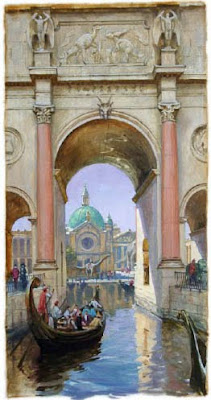 The same kind of thing happens when light bounces up from the water surface. It’s called a caustic reflection. It’s a common sight on the sides of docked sailboats or on the undersides of bridges in Venice.
The same kind of thing happens when light bounces up from the water surface. It’s called a caustic reflection. It’s a common sight on the sides of docked sailboats or on the undersides of bridges in Venice. In this case the caustic lines are fairly parallel to each other because the waves are, too. The light is hitting the water at a low angle (allowing a greater amount of light to be reflected upward), and the caustic reflections spread out and go a little out focus on the near side of the bridge.
 A caustic pattern appears on the inside surface of the vaulted arch in this painting from Dinotopia: Journey to Chandara.
A caustic pattern appears on the inside surface of the vaulted arch in this painting from Dinotopia: Journey to Chandara. This figure shows how the two kinds of caustics work. The waves act like curving mirrors and lenses at the same time.
This figure shows how the two kinds of caustics work. The waves act like curving mirrors and lenses at the same time. -------
Photo by imappi2 on Flickr
Previously on GJ: Caustic Projections

I like your diagram.
ReplyDeleteHere is an example by John Singer Sargent.
Minnaert covers this topic well.
Wow! Have you been spying on me!? Ha ha, I was just dissecting this piece yesterday in my ImagineFX magazine, specifically the reflections of the water on the arch and here's this post today. So weird! Thanks for shedding some light your process.
ReplyDeleteWhat's the best way to do this with traditional paint? It's really easy to do in a digital painting with the dodge tool set to highlight.
ReplyDeleteSeems like it would be harder to get the intense colors to make it look right.
James,
ReplyDeleteIt's very easy to make caustic reflections with a piece of thin, mirrored mylar should you need to reference them on your models. Simply tape the mylar to a board without attempting to make it too flat. You need a point light source such as a sun or tungsten light. Bending the board and/or experimenting with different distances front the subject will change the pattern.
You can use a tray of water too, but you can't control the reflections as easily – and the optical distortion of mylar produces essentially the same effect. It's very bright too, which is helpful when working with artificial light.
Is this from the new book?
ReplyDeleteKingworks, yes, the new book on Color and Light (Nov. 2010) will cover lots of light effects that painters and CG artists need to know about: caustics, subsurface scattering, transmitted light, atmospheric perspective and other fun goodies.
ReplyDeleteWalter, thanks for that helpful tip! For those who aren't familiar, Walter Wick is the photographer who does the amazing "I Spy" books: www.walterwick.com/
Capprotti: Amazing coincidence. I'm glad the topic wasn't too obscure.
Don, great Sargent example. Do you think he wet the surface and lifted those out or used opaque white?
Greg, I think it depends on the paint. I'd use a combination of opaque, transparent, added, and subtracted to keep it from looking contrived.
Subsurface scattering has to do with semitransparent material and especially relates to skin. It's a fairly recent development in 3D computer graphics - the ability to render it. Caustics and other terms are familiar to 3D computer artists who work with such phenomenon to represent the physical world. One phenomenon that is of interest to me as a painter is "fresnel effect" which relates to special materials that change color (and/or value) at the edge (as it turns around on a cylinder). Perhaps a topic for a future blog entry.
ReplyDelete...or as a topic in your upcoming book, if it's not already covered...
ReplyDeleteconcerning the Sargent, in the lower boat you can tell he used opaque white which was a common practice for him. You can also see where he scratched out with a knife a light for the rigging of the ship above. Many of his watercolors are completely transparent, but he was by know means a purist, he wouldn't hesitate to use opaque white when it suited his purpose. He would also use wax as a resist in his watercolors for achieving light values.
ReplyDelete"Do you think he wet the surface and lifted those out or used opaque white?"
ReplyDeleteI think it is impossible to tell for cetain from a web image, but at the lower left it looks to me as though he scraped the damp paint with a thumbnail. On the bigger boat, it may be opaque white - no reason why he wouldn't use two techniques on one picture, especially when working at speed.
tnx mate.
ReplyDeleteThank you very much for this article! I was searching for the formal 'name' of this type of lighting effect. Appreciative for the excellent info., sir.
ReplyDelete